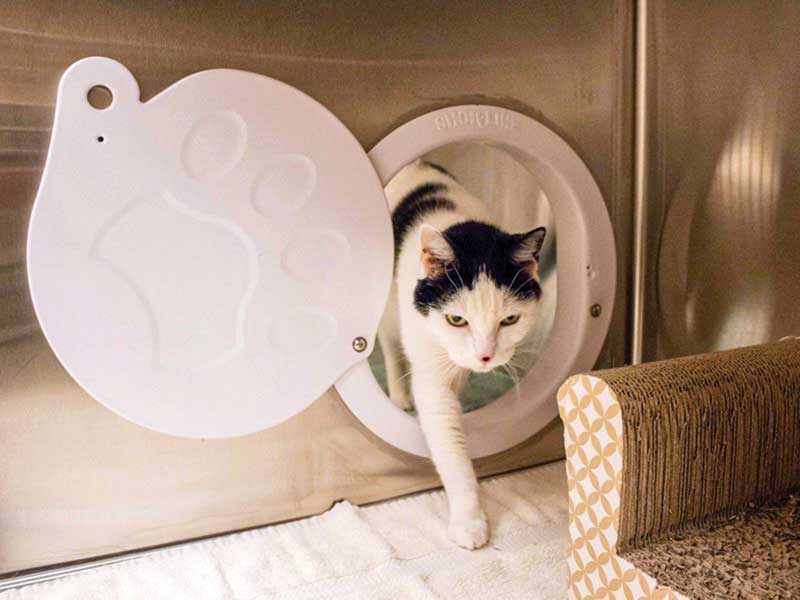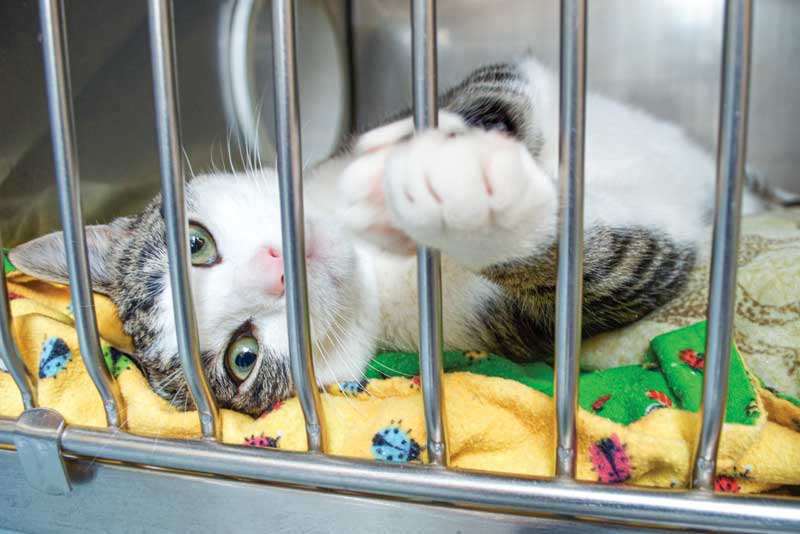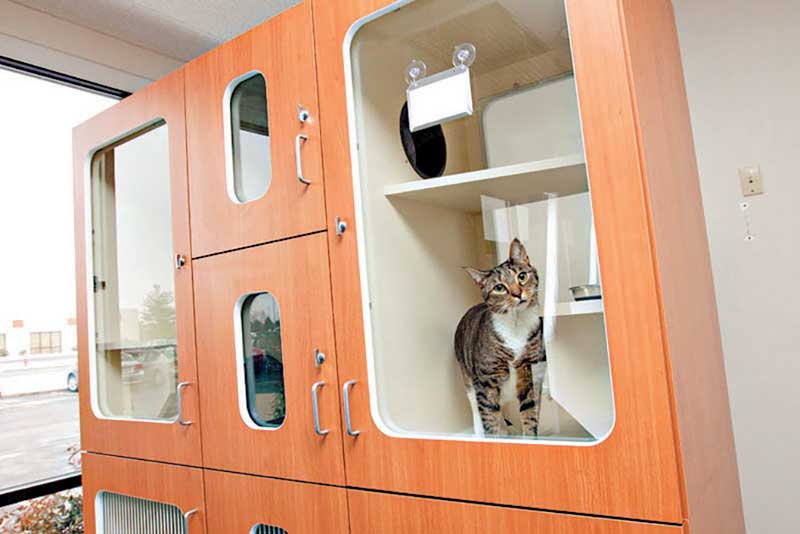
Many of your feline patients will be hospitalized at some point in their lives. Whether for evaluation, treatment, or post-surgical recovery, it can be challenging to provide the best possible care for cats having trouble adjusting to a new environment.
By concentrating on essential feline needs, you can create a containment area that positively affects the cat’s overall well-being and improves your ability to assess and treat them effectively, which can lead to better outcomes for your patients.
Separating spaces
Cats prefer separate areas for food and water, living, and litter. The best way to provide this is by offering double-compartment units connected by a portal or pass-through. Placing bedding and food in one compartment and litter in the other better supports the instinctive feline behavior to avoid eliminating in their sleeping areas.
Portals also offer greater flexibility for your facility—close the portal when you want to clean one side of the unit without disturbing your patient, or if you need to create two separate spaces to increase capacity.
Encouraging movement
Most feline housing is too small for the cat to walk around, make normal postural adjustments, and display natural behaviors that help lessen their anxiety in unfamiliar situations.
How much space does a feline need? Minimally, a single feline housing unit should offer 8 square feet of floor space—ideally, 11 square feet.1 If you need to accommodate multi-cat cohabitation, a minimum of 18 square feet of floor space per adult cat is recommended.1 This is especially important when housing unfamiliar cats together, as they may need more space to maintain distance from each other.
In space-constrained facilities, vertical units can provide adequate room for feline exploration in a smaller footprint, allowing the patient to explore multiple levels from top-to-bottom.
Providing perches and hiding spaces
Extra space is not the only consideration when creating feline-friendly housing. Cats like raised structures, such as integrated perches or shelves, where they can monitor their environment. Simple removable benches allow cats to lounge on top or retreat to the cave-like section underneath and can be easily cleaned and moved as needed.
Hiding is another coping mechanism for cats in unfamiliar places or situations. Help reduce feline stress by providing a place to hide, such as a box or a bed with high sides. For cats with high anxiety, covering the front of their cage can further screen out activities that may add to their stress.
Choosing materials
There are two popular options for feline housing materials: stainless steel for superior sanitation, and “softer” housing solutions crafted from PVC panels that can enhance animal comfort.
Stainless steel has been a classic veterinary choice for containment. It is a waterproof housing solution easy to maintain and sanitize. Its durability and ability to withstand clinical disinfection protocols make it a better option for post-operative containment or housing animals at higher risk for infection.
Choose stainless steel units designed with rounded corners or radiused edges, as opposed to sharp corners that are harder to clean and contribute to bacteria build-up. Some units also incorporate safety features to protect curious feline paws and quiet-closing latches to reduce jarring noises that often startle patients.
PVC is another popular feline housing option. State-of-the-art lamination bonds two sheets of acrylic PVC to an extra-dense foam core that results in an extremely durable and lightweight panel. These softer materials can help lower feline stress by creating a space that is quieter, warmer, non-reflective, and more comfortable for feline paws.

Reducing odors
The scents of other animals in your facility, especially dogs, can be frightening for felines. There are a variety of ventilation options to consider to help reduce smells and lower feline stress.
Stainless steel grill-style gates and doors support passive ventilation, with an openness that encourages natural air circulation. These doors also enable staff to gently interact with patients without opening the door. Active ventilation systems utilize fans and other mechanical means to circulate air and can do a better job of eliminating or drastically reducing smells.
Considering special services
More veterinary hospitals are choosing to provide clients with medical boarding options for cats that need medication or added oversight while their families are away from home. Cats are often more relaxed during boarding experiences when they have larger condominium-style accommodations. “Cat suites” or “kitty condos” are ideal in these circumstances, offering bigger living spaces with separate litter areas. These multi-compartment units also feature perches and portals that provide cats the freedom to move from area
to area.

Enhancing customer experience
Addressing client concerns and fears regarding their hospitalized or boarded cat can help create a positive customer experience. Once you have prepared the housing unit and introduced the cat to the space, consider letting the client enter your containment area to see where their cat will be staying. If it is feasible for your practice, this simple act can calm client fears and enhance their trust in your team.
Creating a living space that allows felines to engage in natural behaviors can reduce their stress while under your care. As you begin exploring feline housing options, do not hesitate to leverage the expertise of your equipment manufacturer to help you choose animal-friendly materials and housing solutions designed to support instinctive feline behaviors. Taking these steps can enhance the experience for everyone involved and help your team deliver the best possible care.
Jose Antonio Valdez is a marketing manager for Midmark Animal Health. Valdez drives downstream marketing strategies to support an extensive animal containment portfolio and brings extensive experience in animal care facility design, helping customers create their ideal spaces for the animal companions in their care.
Reference
- Journal of Shelter Medicine and Community Animal Health 2022. http://dx.doi.org/10.56771/ASVguidelines.2022
